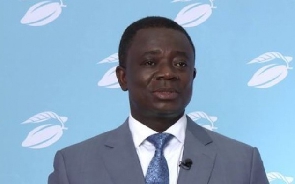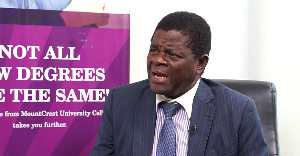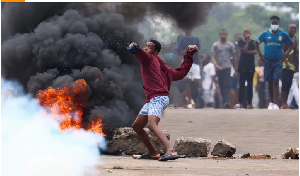The Head of Soil Science Division at CRIG, A. A. Afrifa, has confirmed that the Lithovit fertiliser submitted to him for testing, and which he tested and issued a scientific report on was liquid.
This revelation was contained in Mr Afrifa's evidence to the Adu-Ampomah Committee, whose report recommended the prosecution of a former COCOBOD boss and two others.
The chairman and a member of that committee, Dr Yaw Adu-Ampomah, and Dr F. M. Amoah respectively, who later became the first and third prosecution witnesses, had accused the former COCOBOD Chief Executive, Dr Stephen Opuni of supervising the purchase of Lithovit liquid fertiliser instead of a powdered fertiliser tested by CRIG.
Interestingly, the committee's own report which is already in evidence captured the fact that two out of the three soil scientists at CRIG, including the head of the division, repeatedly said they have always known Lithovit foliar fertiliser as liquid.
This latest development came to light on Monday, April 29, 2024, during the evidence in chief of Mr Jerome Agbesi Dogbatse who is listed as one of the scientists who worked on Lithovit.
The former COCOBOD Chief Executive, Dr Stephen Opuni and businessman Seidu Agongo have been accused of defrauding by false pretences, willfully causing financial loss to the state, corruption by public officers and contravention of the Public Procurement Act.
According to Mr Dogbatse, all the three soil scientists at CRIG – himself, Mr Afrifa and second prosecution witness Dr Alfred Arthur – were made to appear before the committee at the same time.
Mr Jerome Dogbatse, a PhD candidate in soil science, led in evidence by counsel for Seidu Agongo, Mr Benson Nutsukpui, recounted how he and his boss Mr Afrifa, were insistently queried by the Adu-Ampomah Committee about the nature of Lithovit foliar fertiliser.
Both of them, he told the Accra High Court, maintained that the substance was liquid.
“Did you ever say to that committee that lithovit was powder?” Mr Nutsukpui asked the witness. His response was a straightforward, “No”.
Counsel further read out a question posed by Dr Yaw Adu-Ampomah and directed at Mr Afrifa:
“Lithovit too you say these two, Dr Arthur and Mr Dogbatse were involved in preparing the report. But the point is that the lithovit was powder in form. The sample submitted to CRIG was powder. And what is being supplied is liquid, so I want you to tell us more on that.”
Jerome Dogbatse was then made to read Mr Afrifa’s response to the committee:
“He said ‘Chief that one, I can be 100% certain that, it was liquid that was submitted’.”
Mr Dogbatse who has always maintained that the Lithovit he knows is liquid, recalled telling the Adu-Ampomah committee that he saw lithovit liquid fertiliser being used by cocoa farmers when a team of scientists from CRIG went on evaluation rounds in 2016.
He expatiated on term evaluation rounds to the court: “The evaluation rounds is an activity that we undertake, i.e. CRIG, before the coming season application of agro chemicals such as fertilisers, insecticides and fungicides are undertaken by the farmers so for the evaluation purposes, we have a team made up of a soil scientists, a pathologist, an entomologist armed with questionnaires to interview farmers on the previous year’s agro chemical usage so I was privileged to join one of the teams as a soil scientist and my team was tasked to work in the Eastern Region. So we interviewed farmers on various agro chemicals as I mentioned earlier to determine whether there are challenges or benefited from the usage of these agro chemicals. So I interviewed some few farmers.”
Read the Monday’s proceedings below;
Q: When you appear before the Dr. Adu Ampomah’s committee, in an answer to his question, you said you have reviewed the draft report, you were asked by the chairman what is your qualification. Is that correct?
A: Yes that is correct.
Q: And you told him your qualification.
A: Yes I did.
Q: Masters in Soil Science.
A: Yes.
Q: That is in Exhibit H. That is correct.
A: Yes. That is correct.
Q: Can you remember when you appeared before the Dr. Adu Ampomah’s committee how many times the chairman asked you about your qualification?
A: I do not recall.
Q: You were asked if you had seen the report of the scientist before you were given a query.
A: Yes. That is correct.
Q: And you said the first time you saw the report was at EOCO.
A: Yes.
Q: Tell this Court what query was the chairman was talking about.
A: The chairman queried for me to answer the role I played in the testing of lithovit
Q: Flowing from you saying you reviewed the draft report, the chairman asked you if you would list that report as one of your papers on your C.V
A: Yes. The questioned was posed and the answer I gave was that because it is not a published paper you cannot use it on your C.V.
Q: So that is what you mean by you do not use this report in that way?
A: Yes.
Q: The chairman asked you if you can defend the report. That is correct?
A: Yes. That is correct.
Q: And his reason was that your name was on it?
A: That is correct.
Q: do you remember the answer you gave him?
A: I told him I did not participate in the testing of the product but I only review a report on that.
Q: In that report your answer was stated that “No because I played no role in doing the work. I only did a review and the work had already been done before I joined CRIG”. Was that the answer you gave?
A: Yes.
Q: You were shown a copy of the report at that committee meeting. The report on the testing of lithovit. That is correct?
A: Yes. That is correct.
Q:Look at Exhibit B1. (Witness is shown Exhibit B1). Is that a copy of the report that was shown to you at EOCO and the committee meeting?
A:Yes.
Q: And that is the final report you said you had not seen at CRIG. is that the case?
A: Yes.
Q: Look at Exhibit H. The chairman asked you “So when you reviewed the draft report, since then haven’t you read anything about it?
A: Yes I told the chairman after reviewing the draft report I never saw any other report concerning the product lithovit.
Q: Look at the next page. The chairman asked you if you have ever seen lithovit foliar fertilizer being used before.
A: Yes he did ask.
Q: What was your answer?
A: I said yes.
Q: It recorded there that you said yes I have seen the product being used. Did you say that?
A: Yes I did.
Q: Then he asked you the all-powerful question. “What was it, is it powder or liquid?
A: Yes he did.
Q:And you answer was direct. Liquid. I saw it during our evaluation rounds on the farms.
A: Yes I said that.
Q: He asked you when and you said somewhere in 2016. Is that correct?
A: Yes. That is correct.
Q: Please tell this Court. What is evaluation rounds and what role did you play in respect of the evaluation rounds on the farms.
A: The evaluation rounds is an activity that we undertake i.e. CRIG before the coming season application of agro chemicals such as fertilizers, insecticides and fungicides are undertaken by the farmers so for the evaluation purposes, we have a team made up of a Soil scientists, a pathologist an entomologist armed with a questionnaires to interview farmers on the previous year’s agro chemical usage so I was privileged to join one of the teams as a soil scientist and my team was tasked to work in the Eastern Region. So we interviewed farmers on various agro chemicals as I mentioned earlier to determine whether there are challenges or benefited from the usage of these agro chemicals. So I interviewed some few farmers.
Q: So it was during this evaluation rounds in the Eastern Region that you saw lithovit. That is correct?
A: Yes.
Q: Just for my education. You said the team comprises of a pathologist. What does a pathologist do?
A: The pathologist, I mean plant pathologist. Because we have farmers applying fungicides as part of disease control, the questionnaire has questions on fungicide usage so the pathologist presence in the team is supposed to provide backstopping measures for the other members of the team who are not pathologists.
Q: Who is an entomologists and what role do they play?
A: Entomologist is a scientist that deals with insects. On the team just like the pathologist, they provide backstopping information and measures on insects and insecticides used by the farmers.
Q: The chairman asked you “you said you evaluated the product in 2016. Did you come out with a report on the field trial?
A: Yes he did.
Q: Look at Exhibit H. What answer did you give?
A: I told the chairman that our report on the field trial came together with reports on different products not on lithovit alone.
Q: And he asked you if lithovit was one of those products. And you answered yes.
A: That is correct.
Q: They again asked you if you have the report on the field work.
A: Yes. That is correct.
Q: Look at Exhibit H and tell this Court the answer you gave.
A: I responded yes we collected the data and after sorting and collating, we gave the questionnaire and the responses to the lead scientist of the team for further processing.
Q: The process you described in your answer, is that the normal process when you do your field evaluations and trips?
A: Yes.
Q: But the chairman asked you “so you didn’t know the final report of your work”.
A: That is correct.
Q: In your normal course of working as a soil scientist in the team when you do the sorting and collating of the material on the questionnaire and hand over to the lead scientist, is anything else required of you?
A: No. My work as a team member ends.
Q: There and then the chairman asked you the second time; let me ask you again. You said you reviewed the draft report.
A: That is correct.
Q: And you again maintained yes.
A: That is correct.
Q: The chairman then proceeded to ask you “by reviewing the draft report, is it enough for you to be considered as a person who conducted the work of testing the lithovit. From your position as a scientist”? He asked you?
A: Yes he asked me.
Q:What was your answer?
A: I said if you review, that is not enough. If you have your name there, then it means you participated in the work but I was not the only one who did the work. The “but I was not the only one who did the work” should have read “but I was not the one who did the work”.
Q: Indeed before that committee you consistently maintained the position that the work was done before you were employed at CRIG.
A: That is correct.
Q: The chairman went on. “So you are saying that having reviewed the draft report, it is not enough for you to be considered one of the authors. The chairman asked you that.
A: That is correct.
Q: Look at Exhibit H and tell this Court the answer you gave.
A: I said it is not enough, but I got to know that, that was the norm. But I don’t think that is enough. I know other people who reviewed it, whose names are not on the document.
Q: Briefly explain to this Court what you got to know is the norm.
A: I was told that when such testing report is generated from a particular division, it is the division that has done the work so scientists in that division has to have their name on the report.
Q: So your name was on the report not because you reviewed the draft but because of the norm at soil science division of CRIG at the time.
A: That is correct.
Q: After this explanation, the chairman asked you again the third time “So should your name be on this report?
A: Yes he did and I said no it should not.
Q: You were asked by the chairman of the procedure for testing new fertilizer. That is correct?
A: That is correct.
Q: After your answer, the chairman asked you how long you have been at CRIG?
A: Yes. That is correct.
Q: What was your answer?
A: I said November, 4th will be my 4th year.
Q: What was your answer to the chairman’s question that how long does it take to test a new fertilizer on cocoa?
A: My response was, it depends on the type of fertilizer, because all fertilizers are not the same.
Q: He asked you so “a fertilizer like lithovit”?
A: Yes. He did. My response was a fertilizer like lithovit testing would be for a minimum of two years to determine the effectiveness.
Q: He asked you why would you need two years to determine the efficacy.
A: Yes.
Q: And what was your answer?
A:My answer was because it is not the ordinary normal fertilizers that we know with the NPK formulations, so, you need to do the first year after doing the nursery work, if you want to use it on mature cocoa, you need to do the first year, collect yield data and then the second year to confirm what you have done so that you can attribute it to the fertilizer. This paragraph should read this way after the second line “so” it should read “you need to do the first year after doing the nursery work and then the second year to confirm the yield data that you collected in the first year so that you can attribute it to the fertilizer.
Q: After that the chairman went fishing. He asked you does it mean that at the end of the second year you will not do any test to consider the environment.
A: That is correct.
Q: What was your answer?
A: I said for fertilizer, we don’t do that. Fertilizers are just like taking in food; you don’t do the toxicity test.
Q: The chairman asked you. As a soil scientist, would you say that after testing a new fertilizer on seedlings, the result thereof would be enough to conclude that the fertilizer is suitable for fully grown cocoa?
A: Yes he did.
Q: And you told him “yes you can draw the inference but for me if I am in that position I will go further to confirm that”.
A: Yes I did.
Q: You still stand by this.
A: Yes.
Q: The chairman asked you why you gave that answer. Did he?
A: Yes he did.
Q: What was your response?
A: I said, in science, we don’t need to do assumptions. You can infer from what you have but then to be very sure you need to do the confirmation.
Q: After this answer, the chairman who at the time was a very big man. Deputy Chief Executive Agronomy and Quality Control asked you “Then it means that if you decide to infer from the testing of seedlings, that it would work on adult trees, you are not being exact as required by science. Are you”?
A: Yes he did.
Q: What was your answer?
A: I answered yes, but then the inference depends on what you are inferring
Q: He asked you that so inferring that it would do well on fully grown cocoa.
A: Yes he did.
Q: Tell the Court the answer you gave.
A: I said yes it can but then if you are saying doing well it depends on the parameter you are using to judge whether it is well or not. If it is growth parameter, it is a different thing. If it is yield parameter, it is also a different thing.
Q: In all these questions that we have been dealing with this morning. The committee was trying to elicit from you your views on Exhibit B1 i.e. the report before you. That is correct?
COUNSEL FOR REPUBLIC: This is evidence in chief so when you try to suggest to the witness that this is what the committee is trying to do is not an evidence-in-chief.
COUNSEL FOR 2ND AND 3RD ACCUSED: The witness answers questions on the Exhibits. I have to elicit
BY COURT: You have to vary the question.
Q:When you appear before the committee and they asked you all these questions, what did you think they wanted from you?
A: They wanted me to answer to the query that brought me to the committee.
Q: What was the query that brought you to the committee?
A: The query was for me to explain the role I played in the testing of lithovit.
Q: Look at Exhibit B1. What is Exhibit B1?
A: It is a report on lithovit foliar fertilizer.
Q: Was your appearance before the committee related to exhibit B1 in anyway?
A: Yes.
Q: What is the relationship between your appearance before the committee and Exhibit B1?
A: The relationship is that this report bears my name and the query is for me to answer question on the testing of Lithovit foliar fertilizer so the report is a product of work done in the testing of Lithovit foliar fertilizer.
Q: As a scientist, how do you come to comment on scientific investigation?
A: When questions are posed to you or when you are invited to comment.
Q: What entitles you as a scientist to comment on a scientific report?
A: like I just said, upon invitation and the invitation will come to you because you are an expert in the field.
Q: You told the committee that if you are considering yield, you will go further to confirm on the field. That is correct.
A: Yes. That is correct.
Q: Go to the end of that page. The chairman asked you “so it is not proper for anybody to draw conclusion on yield based on testing on seedlings only. Have you seen the question?
A: Yes I have.
Q: What was your answer?
A: Yes. I said for me I will not take that chance.
Q: And it is true also that the chairman again asked you “so is it proper for somebody to draw conclusion based on testing on seedlings only. He asked you that?
A: Yes he did.
Q: Tell the Court your answer.
A: I said yes. It depends on the information the person get but I would not just stop at the nursery. I will go further to confirm more. I don’t know what informed the basis for whoever drew the conclusion. But in my case if I am in that position, it is better to go to the field so that you are sure before you draw the conclusion so I don’t know the sort of information the person might have.
Q:So the information that was available to whoever drew the conclusion as you have stated here, do you have that information?
A: No.
Q: Would you ordinarily comment on scientific work that was done before you were employed at CRIG.
A: Yes. When the scientific work is brought to my attention for my comment.
Q: What would be the basis of commenting on the work? How would you go about commenting on the scientific work?
A: It would be based on information provided for me to comment.
Q:So scientific comments could be based on scientific knowledge or data available at the time.
A: Yes. That is correct.
Q: And that is what you will take into consideration when you are viewing scientific work on your peers.
A: Yes.
Q: The chairman asked you “so when you reviewed the draft report you didn’t see the fertilizers had been tested on seedlings only”. He asked you?
A: Yes. My response was yes, when I reviewed it, the work was basically on seedlings. There was nothing like yield information.
Q:He also said that there was no conclusion that it could be used on matured tree. He said so?
A: Yes.
Q: At the committee, tell this Court how your appearance before the committee was. Were you alone at the time you appeared before the committee?
A: No.
Q: So how was the appearance like?
A: I was there with Mr. A.A Afrifa, the head of the Soil Science Division and my senior colleague Dr. Alfred Arthur.
Q: You all appeared at the same time?
A: Yes.
Q: And at that meeting Mr. A. A. Afrifa maintained. In fact his words were “I can say 100% that lithovit is liquid”.
A: Yes I recall he said it was liquid but the 100% I don’t recall.
Q: On page 28 of Exhibit H under the heading lithovit. Read the question the chairman asked Dr. A. A. Afrifa.
A: The question reads; “lithovit too you say these two, Dr. Arthur and Mr. Dogbatse were involved in preparing the report. But the point is that the lithovit was powder in form. The sample submitted to CRIG was powder. And what is being supplied is liquid, so I want you to tell us more on that”.
Q:Did you ever say to that committee that lithovit was powder?
A: No.
Q: What was the answer Afrifa gave to the committee?
A: He said “Chief that one, I can be 100% certain that, it was liquid that was submitted”.
Watch the latest edition of BizTech below:
Ghana’s leading digital news platform, GhanaWeb, in conjunction with the Korle-Bu Teaching Hospital, is embarking on an aggressive campaign which is geared towards ensuring that parliament passes comprehensive legislation to guide organ harvesting, organ donation, and organ transplantation in the country.
Click here to follow the GhanaWeb Business WhatsApp channel
Business News of Wednesday, 1 May 2024
Source: classfmonline.com

















